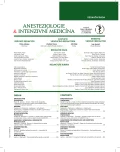The correlation between the citrate contained in the transfused blood products and the plasma concentration of ionised calcium in cardiac surgery patients
Authors:
M. Mynář 1; J. Samek 1,2; Z. Turek 1,2
Authors‘ workplace:
Klinika anesteziologie, resuscitace a intenzivní medicíny, Fakultní nemocnice Hradec Králové, Univerzita
Karlova, Lékařská fakulta v Hradci Králové
1; Kardiochirurgická klinika, Oddělení mimotělního oběhu a podpůrných systémů, Fakultní nemocnice Hradec
Králové, Univerzita Karlova, Lékařská fakulta v Hradci Králové
2
Published in:
Anest. intenziv. Med., 28, 2017, č. 2, s. 75-79
Category:
Anaesthesiology - Original Paper
Overview
Objective:
The goal of the study was to evaluate the correlation between the dose of infused citrate and plasma ionized calcium changes in cardiac surgery patients requiring transfusion treatment. The secondary goal was to establish the incidence of perioperative hypocalcaemia.
Design:
Prospective, observational, non-interventional study.
Setting:
Department of Anaesthesia and Intensive Care Medicine, University Hospital Hradec Kralove, Charles University, Faculty of Medicine, Hradec Kralove.
Patients and methods:
During the study period, 42 cardiac surgery patients treated with transfusion were enrolled into the study. All the patients underwent cardiac surgery procedures using cardiopulmonary bypass. Blood samples for blood gases, acid base balance and biochemistry were taken before transfusion, just after finishing and at the time of ICU admission, and on the first postoperative day. Correlation analysis was used to detect correlation between the infused citrate load and the plasma ionized calcium change. Statistical analysis was performed to evaluate the statistical significance of ionized calcium and pH alterations between measurements.
Result:
No correlation between the infused citrate load and the plasma ionized calcium change was found, with correlation coefficient r = -0.21, α = 0.01. There was statistically significant decrease in the value of the plasma ionized calcium before and just after finishing the transfusion treatment (p < 0.05). No ionized hypocalcaemia was detected throughout the study.
Conclusion:
We found no correlation between the citrate load in the transfusion units and the plasma ionized calcium, using routine perioperative measurement of ionized calcium. Routine measurement of ionized calcium during transfusion treatment may eliminate the empirical bolus administration of calcium, which can be risky in many cardiac surgery patients.
KEYWORDS:
ionized hypocalcaemia – transfusion – cardiopulmonary bypass
Sources
1. Zadák Z. Výživa v intenzivní péči. 2. vydání. Praha: Grada, 2008, ISBN 8024728443.
2. Marino PL. The ICU book. 4th edition. Philadelpbia: Wolters Kluwer, 2013, ISBN 1451188692.
3. Parrillo J, et al. Critical care medicine: principles of diagnosis and management in the adult. 4th ed. Philadelphia, PA: Elsevier/Saunders, 2014. ISBN 0323089291.
4. Derek M, Yellon D, Hausenloy DJ. Myocardial Reperfusion Injury. N Engl J Med. 2007; 357:1121–1135.
5. Denlinger JK, Nahrwold ML, Gibbs PS, Lecky, JH. Hypocalcemia during rapid blood transfusion in anaesthetized man. BJA. 1976;48(10):995–1000.
6. Kahn RC, Jascott D, Graziano C, Schweizer O, Howland O, Goldiner WS, Paul L. Massive Blood Replacement: Correlation of Ionized Calcium, Citrate, and Hydrogen Ion Concentration. Anesth & Analg. 1979;58, 274–278.
7. Lier H. Incidence and significance of reduced ionised calcium in massive transfusion. Internat Journal of Intensive Care. 2012; 56, 130–133.
8. Spahn DR, et al. Management of bleeding and coagulopathy following major trauma: an update European guideline. Crit Care Med. 2013, 19;17(2):R76.
9. Gregory M, Janelle MD, Felipe Urdaneta, Tomas D. Martin, MD, Janelle, MG, Urdaneta F, Martin TD, Lobato EB. Effects of calcium chloride on grafted internal mammary artery flow after cardiopulmonary bypass, Journal of Cardiothoracic and Vascular Anesthesia J Cardiothorac Vasc Anesth. 2000;14: 4–8.
10. Koski G. Internal mammary artery spasm: is calcium the culprit? J Cardiothorac Vasc Anesth, 2000;14:1–3.
11. Levick JR. An introduction to cardiovascular physiology. 5th ed. London: Hodder Arnold, 2010, ISBN 978-0-340-94204-8.
12. Aguilera IM, Vaughan RS. Calcium and the anaesthetist, Anaesthesia. 2000;55:779–790.
13. Vivien B, Langeron O, Morell E, Devilliers C, Carli P. Early hypocalcemia in severe trauma, Crit Care Med. 2005;33: 1946–1952.
14. Cherry RA, Bradburn E, Shaffer DE, Gabbay ML. Do Early Ionized Calcium Levels Really Matter in Trauma Patients? Journal of Trauma-Injury Infection & Crit Care. 2006;61:774–779.
15. King WH, Patten ED, Bee DE. An In Vitro Evaluation of Ionized Calcium Levels and Clotting in Red Blood Cells Diluted With Lactated Ringer‘s Solution. Anesthesiology, 1988, 68: 115–121.
Labels
Anaesthesiology, Resuscitation and Inten Intensive Care MedicineArticle was published in
Anaesthesiology and Intensive Care Medicine

2017 Issue 2
Most read in this issue
- Deep vein thrombosis and pulmonary embolism in pregnancy
- Inhalational application of furosemide – the breathlessness panacea?
- Dexmedetomidine and its use in anaesthesia and intensive care
- The physician and the law II – forensic medical experts and expert institutions
